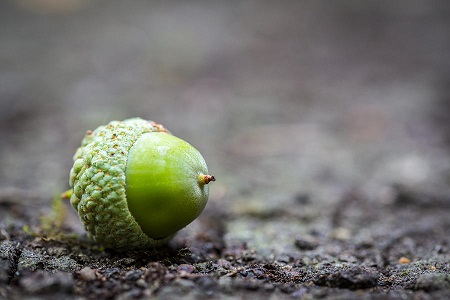January 2, 2024 – The howling winds of cold fronts and rainstorms often knock green acorns from oak trees in a pasture. Most cattle like the taste of acorns and tend to seek them out. But hungry cattle that consume too many green acorns will get sick. Their gastrointestinal tracts will be upset; they will develop diarrhea, become dehydrated, constipated and emaciated; and they might die.
Acorn poisoning is caused by chemicals called tannins. It generally occurs when acorns fall off trees in the immature green stage, followed by overconsumption by cattle. This usually occurs in pastures where there is not much grass left nor hay fed. Poisoning from oak tannins also can occur when cattle eat buds and young leaves of oaks (shrubs and trees) in early spring. Sickness starts 8 to 14 days after the cattle have started eating acorns.
The amount tolerated by an animal is influenced by the protein content of its diet. If the protein intake is high, the animal can consume more acorns without having poisoning symptoms. Cattle affected by acorn poisoning have a poor appetite, appear dull, become constipated, suffer weight loss and look gaunt or “tucked up.” They also may pass blood in the manure and/or bleed from the nostrils. Profuse diarrhea may follow after the constipation.
Affected animals drink large amounts of water and void excessive amounts of clear urine (urine may also contain blood). Many animals go down and cannot rise after 3 to 7 days of clinical signs of acorn poisoning. If these affected animals do not die, it may take as long as 2 to 3 weeks before they start to recover. Producers suspecting such a problem should contact a veterinarian as soon as possible.
To correct the protein and energy deficiencies of a stressed, thin cow herd, provide plenty of good-quality hay. When feeding hay, consider both the quantity and quality fed, and supplement it if needed with the proper amounts of protein and/or energy supplements. Providing hay that is of poor quality—even in large amounts—might provide adequate energy, but the cattle will be deficient in protein. Providing good hay but not enough of it can improve the protein deficiency but leave the cattle lacking in energy.
Treatment is of little value in severely affected cattle. However, for the other cattle remaining on the “poor” oak tree pasture, provide supplemental feed containing hydrated lime (calcium hydroxide) and protein, which are “antidotes” for the tannins. Mix and cube the following feed formulation for breeding cattle (4 pounds per head per day) and use it as a meal creep feed for calves (free-choice lime limits consumption like salt): Cottonseed meal: 1,040 pounds (52 percent) Dehydrated alfalfa leaf meal: 600 pounds (30 percent) Vegetable oil: 160 pounds 8 percent) Hydrated lime: 200 pounds (10 percent).
Obviously, acorn poisoning can be prevented by removing cattle from areas with oak trees when acorns have recently fallen. Reserve these pastures for grazing in late fall or winter, when the acorns have had a chance to age, turn brown and become somewhat less toxic. No matter when the cattle are turned onto “poor” oak tree pasture, remember that they still could be affected if they eat too many acorns.







